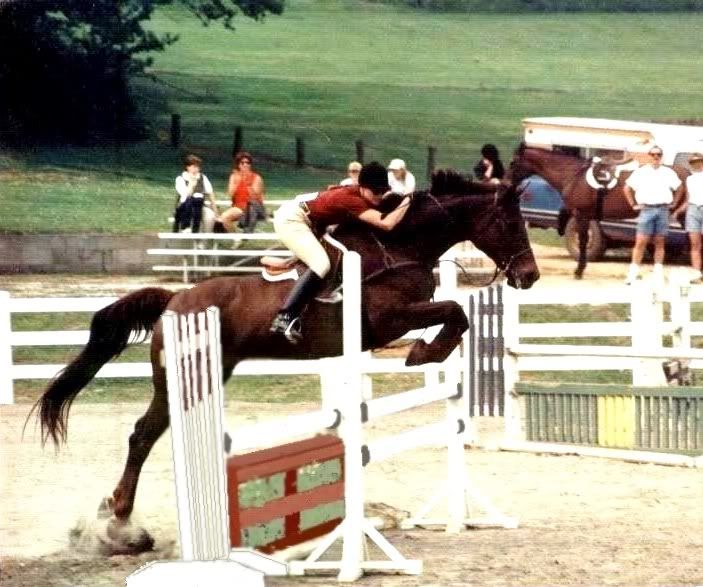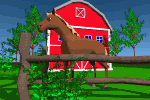Post by Heather T on Apr 9, 2007 6:42:05 GMT -5
Just got this email from my wonderful farrier and thought others may benefit from it as well (with a nudge from my dear friend Deb) 
Hi everyone,
As many of you know (all of you should know) spring grass is
particularly problematic as a factor for laminitis. Here in the
southeast, right now, we have a convergence of elements that make your
spring pastures far more dangerous for founder prone horses than the usual.
Spring grass is high in sugars. Stressed grass accumulates even more
sugar. Mainly that is grass that is stressed by drought and grass
stressed by cold. Right now we have both....lack of rain and extreme
cold at a time when grass is already dangerous in the sense of normal
spring growth. All three things happening at the same time...spring
growth, dry weather and cold makes this spring more dangerous than usual
in my estimation. Even horses that are not normally visibly affected in
the spring may struggle this year.
That is a simplistic explanation but you can study
www.safergrass.org to learn more.
Things you can do (if you are not already):
1. If your pasture already has a good stand of grass, get grazing
muzzles on your horses.
2. If your horse is already at risk, dry lot him and put him on hay.
3. If you are feeding grain or processed feed, reduce or eliminate it
other than a handful to get any needed supplements or medication your
horse requires.
4. If you have some of the MOP detox product I suggest to many of my
customers, get them on it for a 30 day course as a prevention, or talk
to your hoof care professional or holistic vet for their recommendation
for prevention.
5. If you are not already on a program with a holistic vet, then ask
your conventional vet if you can hold off on spring vaccinations or
worming or at the very least, spread out what is given over time to
minimize the impact of those additional stressors to the horses'
bodies...this unusual grass/temperature/climate issue is stress enough.
6. Keep a close eye on your horses for any signs of lameness, stiffness,
developing fat pads, swollen sheaths. Do a "Crest Check" every day if
you can to monitor the hardness of the neck crest....that is an
indicator that you horse is heading toward a laminitic event although it
is not fool proof. Non-cresty horses can founder too.
Those of you who are already watchful for spring grass issues, many need
to step up your vigilance with this stronger than unusual combination of
climate factors.
Donkeys are already more sensitive to grass issues than horses, just by
their nature, so donkey owners - you need to pay particular attention.
If you don't have a dry lot, right now would be a good time to build
one! At the very least you can get grazing muzzles on those horses that
must stay on pasture ASAP! Work with your team of professionals and be
vigilant and hopefully we can all ride through this spring with minimal
impact to our horses.
Hopefully nothing will come of this...but it struck me as an unusual
convergence of events known to cause problems ...so better safe than sorry!
Keep-em safe!
Cindy

Hi everyone,
As many of you know (all of you should know) spring grass is
particularly problematic as a factor for laminitis. Here in the
southeast, right now, we have a convergence of elements that make your
spring pastures far more dangerous for founder prone horses than the usual.
Spring grass is high in sugars. Stressed grass accumulates even more
sugar. Mainly that is grass that is stressed by drought and grass
stressed by cold. Right now we have both....lack of rain and extreme
cold at a time when grass is already dangerous in the sense of normal
spring growth. All three things happening at the same time...spring
growth, dry weather and cold makes this spring more dangerous than usual
in my estimation. Even horses that are not normally visibly affected in
the spring may struggle this year.
That is a simplistic explanation but you can study
www.safergrass.org to learn more.
Things you can do (if you are not already):
1. If your pasture already has a good stand of grass, get grazing
muzzles on your horses.
2. If your horse is already at risk, dry lot him and put him on hay.
3. If you are feeding grain or processed feed, reduce or eliminate it
other than a handful to get any needed supplements or medication your
horse requires.
4. If you have some of the MOP detox product I suggest to many of my
customers, get them on it for a 30 day course as a prevention, or talk
to your hoof care professional or holistic vet for their recommendation
for prevention.
5. If you are not already on a program with a holistic vet, then ask
your conventional vet if you can hold off on spring vaccinations or
worming or at the very least, spread out what is given over time to
minimize the impact of those additional stressors to the horses'
bodies...this unusual grass/temperature/climate issue is stress enough.
6. Keep a close eye on your horses for any signs of lameness, stiffness,
developing fat pads, swollen sheaths. Do a "Crest Check" every day if
you can to monitor the hardness of the neck crest....that is an
indicator that you horse is heading toward a laminitic event although it
is not fool proof. Non-cresty horses can founder too.
Those of you who are already watchful for spring grass issues, many need
to step up your vigilance with this stronger than unusual combination of
climate factors.
Donkeys are already more sensitive to grass issues than horses, just by
their nature, so donkey owners - you need to pay particular attention.
If you don't have a dry lot, right now would be a good time to build
one! At the very least you can get grazing muzzles on those horses that
must stay on pasture ASAP! Work with your team of professionals and be
vigilant and hopefully we can all ride through this spring with minimal
impact to our horses.
Hopefully nothing will come of this...but it struck me as an unusual
convergence of events known to cause problems ...so better safe than sorry!
Keep-em safe!
Cindy






 ) but he cut the grass really short & finally threw them some hay. I haven't called back though, so I can only hope that they hadn't foundered too bad
) but he cut the grass really short & finally threw them some hay. I haven't called back though, so I can only hope that they hadn't foundered too bad  yet. This morning all three were on their feet, so I am thinking that he caught them early enough.
yet. This morning all three were on their feet, so I am thinking that he caught them early enough. 


 that is why you see two of mine in their stalls one has coffin bone rotation and the other has cushing sydrome. It is not a happy thing for them and less for me. But i will do what i need to keep them as healthy as i can. They can go out but they have sand to run in.
that is why you see two of mine in their stalls one has coffin bone rotation and the other has cushing sydrome. It is not a happy thing for them and less for me. But i will do what i need to keep them as healthy as i can. They can go out but they have sand to run in.